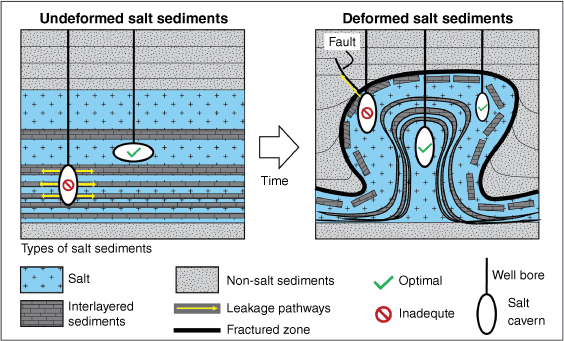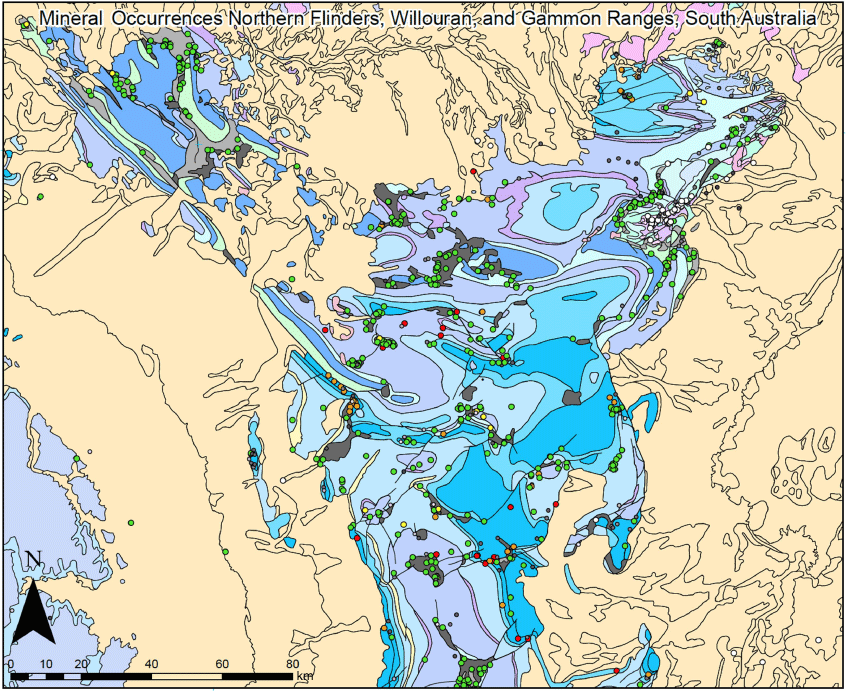The role of salt basins in the race to net zero: a focus on Australian basins and key research topics
Rachelle Kernen A * , Kathryn J. Amos
A * , Kathryn J. Amos  A , Ingrid Anell
A , Ingrid Anell  B , Sian Evans B and Leticia Rodriguez-Blanco
B , Sian Evans B and Leticia Rodriguez-Blanco  B
B
A
B

Rachelle Kernen is a Postdoctoral Fellow at the University of Adelaide. She received Industry Fellowships for her MSc (2011) and PhD (2019) and was an exploration geoscientist for the Royal Dutch Shell. Her research focusses on outcrop and subsurface salt–sediment interaction across US and Australian salt basins. |

Kathryn Amos is an Associate Professor of sedimentology, stratigraphy, and geoenergy at the University of Adelaide. Her research is focussed on improving understanding of the controls on sediment transport and deposition processes, from recent deposits to the rock record. |

Ingrid Anell is an Associate Professor in sedimentology, and Deputy Section Lead for Applied Basin Analysis at the University of Oslo, and an Adjunct Associate Professor at the University Center in Svalbard. Her research focusses on the fundamental controls of clinoform geometries, sediment partitioning, and influence on CO2 storage. |

Sian Evans is a Postdoctoral Research Fellow at the University of Oslo as part of the NCCS Research Centre. Her current research focusses on the influence of salt tectonics on site selection and seal integrity for CO2 storage in the Norwegian-Danish Basin, offshore Norway. |

Leticia Rodriguez-Blanco is a PhD Fellow at the University of Oslo. She won a Fulbright scholarship (2014) and Best MS Thesis Prize (2017). Her research focusses on 3D outcrop models as subsurface analogues, investigating controls on clinoform geometries and sediment partitioning in prograding systems. |
Abstract
Globally, many salt basins host highly productive fossil fuel resources and provide excellent opportunities for developing economically viable clean energy systems such as (1) energy storage in salt caverns, including hydrogen, helium, natural gas, and other economic gases; (2) permanent sequestration of carbon dioxide; (3) development of geothermal energy; (4) critical mineral exploration and extraction, and (5) natural hydrogen production. Despite the high potential to deploy financially viable clean energy solutions related to the formation and evolution of salt basins, our current knowledge regarding critical aspects of salt basin characterisation in Australia is limited. New research is necessary to develop these sustainable energy systems and achieve net zero emissions; therefore, it is critical to re-evaluate the geology of salt basins. Key research areas to enable these opportunities relate to the precipitation, deposition, and deformation of salt basins. This paper reviews the potential for a range of energy systems within salt basins, outlines emerging research topics, and demonstrates the value of Australian salt basin outcrop analogues for improved subsurface interpretation globally.
Keywords: carbon capture, energy storage, geothermal, geo-energy, halite, mineral exploration, natural hydrogen, net zero, salt basins, salt tectonics, salt–sediment interaction.
Introduction
To date, only six countries responsible for 8% of global greenhouse gas emissions have defined their net zero targets in an achievable manner (IEA 2023). Substantial commitment is still needed to reach net zero by 2050, and doing so requires a technical transformation of the energy systems that underpin our societies. Various geological energy systems provide demonstrated and economically viable options; thus, we are in a critical decade for high-calibre geological research to underpin achieving net zero emissions and transforming to a sustainable energy economy. Typically, exploration strategies are siloed between the petroleum, mining, and emerging clean energy industries. Here, we focus on salt basins and review the sustainable geoenergy system applications these basins offer, highlighting the critical research opportunities. Rather than individually estimating the resource potential within each end-member sector, we propose a holistic geo-energy systems approach for resources within salt basins, allowing more effective portfolio diversification to unlock economic potential.
In Australia, approximately 15 salt basins have been identified (Bradshaw et al. 2023), including several with substantial opportunity for resource exploration and storage (Amadeus, Officer, Polda, Canning, Adavale Basins), as well as research development via outcrop studies (Flinders, Willouran, Gammon Ranges; Table 1). Here, we review energy transition opportunities in salt basins, focussed on Australian basins.
| Location within Australia | Research type | Salt caverns | CO2 storage | Geothermal energy | Mineral deposits | Natural hydrogen | |
|---|---|---|---|---|---|---|---|
| Willouran Ranges | Outcrop | ✓ | ✓ | ✓ | ✓ | ✓ | |
| Flinders Ranges | ✓ | ✓ | ✓ | ✓ | ✓ | ||
| Gammon Ranges | ⨯ | ∼ | ✓ | ✓ | ✓ | ||
| Amadeus Basin | Subsurface | ✓ | ✓ | ✓ | ✓ | ✓ | |
| Officer Basin | ✓ | ✓ | ✓ | ✓ | ✓ | ||
| Polda Basin | ✓ | ✓ | ✓ | ✓ | ✓ | ||
| Canning Basin | ✓ | ✓ | ✓ | ✓ | ✓ | ||
| Adavale Basin | ✓ | ✓ | ✓ | ✓ | ✓ |
Colours indicate relevance and opportunity for research as follows:
Dark green (✓), known
Light green (✓), unknown but likely exists
Yellow (∼), unknown
Red (⨯), does not exist
Energy storage in salt caverns
Salt caverns provide various benefits for storing resources and managing energy supply. Manufactured salt caverns are created by an engineering process known as solution mining, in which fresh or semi-fresh water is pumped into a salt formation to generate partial dissolution. The resulting brine is pumped to the surface to be evaporated and analysed for critical minerals, creating caverns within the subsurface. Salt caverns have unique sealing properties (Ratigan 1995) that are ideal for storing various substances, including crude oil, natural gas, hydrocarbons, chemicals, hydrogen, compressed air, biofuels, and nuclear waste.
Salt deposits are often interlayered with other sedimentary deposits, sometimes deformed into structurally complex folds and faults (Rowan et al. 2019). Because the internal sedimentological and structural characteristics are understudied within salt sequences, their properties and influence on salt caverns are largely unknown. Furthermore, the unique physical and chemical properties of salt that make it excellent for storage also make it difficult to image through geophysical methods. Thus, characterising heterogeneities within the salt succession is challenging (Kernen et al. 2021). Salt heterogeneities are a significant issue in Australian basins, further complicated by poor historical 2D seismic data density and quality. New outcrop and subsurface research within salt sequences and diapirs characterising internal architecture and heterogeneities must be conducted to ensure optimal salt cavern placement (Fig. 1, Table 1).
CO2 storage
Carbon capture and storage (CCS) will be necessary to decarbonise hard-to-abate industrial sectors. Carbon dioxide (CO2) can be injected and permanently stored within porous sedimentary deposits in the subsurface. The injected CO2 is initially buoyant and will flow upward and away from the injection point until a trap is reached. The trap containing the CO2 must be sealed by an overlying impermeable unit, such as shale or salt, so that the CO2 is contained within the trap, dissolves in the pore water and eventually becomes mineralised. A long migration path from the injection point to the final trap can increase the overall storage capacity by increasing residual trapping efficiency and avoiding pressure build-up.
Salt has a unique rheology in sedimentary basins, deforming as a viscous fluid on geological timescales and generating complex 3D geometries during halokinesis. The associated structural deformation of the sedimentary deposits overlying the salt layer creates a variety of potential trap structures, and salt basins, therefore, host large potential capacities for CO2 storage (Duffy et al. 2023). Salt deformation also influences the deposition of overlying sediments by creating basinal highs and lows around which depositional systems are redirected, and local erosion of those deposits can occur. This process leads to complex sedimentological heterogeneity near the salt body and therefore affects the flow of CO2. Additionally, the salt layer itself can make an excellent seal for CO2 if traps in the subsalt strata are targeted. Further research into the impact of salt tectonics on subsurface fluid flow and seal integrity is required to unlock the great potential for CO2 storage in salt basins, as highlighted by observations in key Flinders and Willouran Ranges outcrop analogues and subsequent modelling.
Geothermal energy
Geothermal energy can provide an excellent low-carbon fuel or local heating system if exploited cost-effectively. The thermal conductivity of halite is two to four times higher than that of non-evaporitic sediments (Daniilidis and Herber 2017). This means that salt bodies provide paths of low thermal resistance for heat conduction from depth to the surface. As a result, heat is focussed through the salt body rather than surrounding sediments. The focussed heat will re-enter the sediments near the apex of the salt structure so that sediments around the salt apex are warmer than the sediments at the same depth, away from the salt structure. These shallow geothermal anomalies above the crests of salt structures provide accessible heat sources. In 2009, temperatures of 98.4°C were observed at a depth of 1807 m in Treebeard 1A, Flinders Ranges (NS Energy 2009). Treebeard 1A encountered high temperatures much shallower than expected due to the nearby salt bodies. Further research modelling heat flow associated with salt bodies is needed to understand their potential for geothermal energy production in salt basins.
Critical mineral deposits
The relationship between salt diapirs, fluid flow, and base metal mineralisation is widely recognised across the US Gulf Coast (Caesar et al. 2019), Southern Europe (Leach et al. 2006), North Africa (Rddad et al. 2019) and South Australia (Coats and Blissett 1971; Kernen et al. 2020). In the Willouran, Gammon, and Flinders Ranges, diapir-related Mississippi Valley-Type lead-zinc deposits, copper, and gold are distributed around regional-trending faults linking diapirs at or near the salt–sediment interface or within the diapiric matrix occurring as stratabound veins, stockworks, and cavity-filling orebodies. These outcrops provide an opportunity for excellent research case studies for characterising the style and orientation of mineralisation trends (Fig. 2).
Natural hydrogen
Natural hydrogen accumulation in salt basins occurs because halite is a highly effective seal (Hand 2023). There are several different origins for naturally occurring hydrogen in salt basins: (1) early biodegradation of interbedded organic shales or coal where trapped hydrogen is within the crystalline halite or potash fluid inclusions; (2) production by radiolysis associated with sylvite and carnallite (Smetannikov 2011); and (3) migration from an underlying basement source (Hand 2023). Reports of economic hydrogen accumulations are often associated with fossil fuels such as methane (Smetannikov 2011); therefore, we must utilise existing knowledge from the petroleum industry to research natural hydrogen systems. To better understand the economic potential of these scenarios, characterising the outcropping layered evaporite sequences containing sylvite and carnallite in the Willouran and Gammon Ranges will be essential in understanding where those sequences are for any regional-trending faults linking diapirs at or near the salt–sediment interface or within the diapiric matrix.
Conclusions
Australia contains unique salt basins, providing opportunities for decarbonisation and clean geo-energy systems through resource exploration and energy storage. To achieve this, fundamental research questions highlighted in this paper must be answered using outcrop analogues and available subsurface data. Australia’s salt basin outcrops provide rare and exceptional sedimentological, stratigraphic, and structural parameters that can be used as analogues for improved interpretation of sparse or poor-quality subsurface datasets globally. By deploying a multi-disciplinary approach, outcrop studies will improve understanding of the integral relationships between regional tectonics, sedimentation, sea level, climate, and salt movement through geologic time. These analogue studies provide the opportunity to improve computational and physical models for subsurface application and develop a predictive framework for characterising the sustainable development potential of salt basins. In order to maximise the valuable resources offered by salt basins in the energy transition, we must consider the integrated potential of these systems and how they can co-exist within an individual basin. Only by considering all sustainable geo-energy systems and the fundamental role of salt basin research in enabling these applications will decarbonisation be possible and have enough impact to reach net zero by 2050.
Acknowledgements
We acknowledge the Traditional Custodians of country throughout Australia and their connections to land, waters, seas and community. We pay our respects to their Elders, past and present, and extend that respect to all Aboriginal and Torres Strait Islander people today. This manuscript was led by Kernen, with equal co-author contributions made by Amos, Anell, Evans, and Rodriguez-Blanco. To reflect this, co-authors are listed alphabetically.
References
Bradshaw M, Rees S, Wang L, et al. (2023) Australian salt basins – options for underground hydrogen storage. The APPEA Journal 63, 285-304.
| Crossref | Google Scholar |
Caesar KH, Kyle JR, Lyons TW, et al. (2019) Carbonate formation in salt dome cap rocks by microbial anaerobic oxidation of methane. Nature Communications 10, 808.
| Crossref | Google Scholar | PubMed |
Daniilidis A, Herber R (2017) Salt intrusions providing a new geothermal exploration target for higher energy recovery at shallower depths. Energy 118, 658-70.
| Crossref | Google Scholar |
Duffy O, Hudec M, Peel F, et al. (2023) The Role of Salt Tectonics in the Energy Transition: An Overview and Future Challenges. Tektonika 1.1, 1-31.
| Crossref | Google Scholar |
Hand E (2023) Hidden Hydrogen, Does Earth hold vast stores of a renewable, carbon-free fuel? Science 379(6633), 630-636.
| Crossref | Google Scholar | PubMed |
IEA (2023) ‘World Energy Investment 2023.’ (IEA: Paris) Available at https://www.iea.org/reports/world-energy-investment-2023
Kernen RA, Giles KA, Poe PL, et al. (2020) Origin of the Neoproterozoic rim dolomite as lateral carbonate caprock, Patawarta salt sheet, Flinders Ranges, South Australia. Australian Journal of Earth Sciences 67(6), 815-832.
| Crossref | Google Scholar |
Kernen RA, Lehrmann A, Poe P (2021) Lithostratigraphy and Chemostratigraphy of salt diapir sedimentary inclusions: unravelling Ediacaran salt tectonics in the Flinders Ranges, South Australia. MESA Journal 95, 4-29.
| Google Scholar |
Leach D, Macquar JC, Lagneau V, et al. (2006) Precipitation of lead–zinc ores in the Mississippi Valley‐type deposit at Trèves, Cévennes region of southern France. Geofluids 6(1), 24-44.
| Crossref | Google Scholar |
NS Energy (2009) Torrens Energy Completes Validation Drilling At Parachilna Geothermal Play In South Australia. Available at https://www.nsenergybusiness.com/news/newstorrens_energy_completes_validation_drilling_at_parachilna_geothermal_play_in_south_australia_091019/
Rddad L, Jemmali N, Sośnicka M, Cousens B (2019) The genesis of the salt diapir-related Mississippi Valley-type Ba-Pb-(±Zn) ore of the Slata district, Tunisia: the role of Halokinesis, Hydrocarbon migration, and Alpine Orogenesis. Economic Geology 114, 1599-1620.
| Crossref | Google Scholar |
Rowan MG, Urai JL, Fiduk JC, Kukla PA (2019) Deformation of intrasalt competent layers in different modes of salt tectonics. Solid Earth 10, 987-1013.
| Crossref | Google Scholar |
Smetannikov AF (2011) Hydrogen generation during the radiolysis of crystallization water in carnallite and possible consequences of this process. Geochemistry International 49, 916-924.
| Crossref | Google Scholar |
 Rachelle Kernen is a Postdoctoral Fellow at the University of Adelaide. She received Industry Fellowships for her MSc (2011) and PhD (2019) and was an exploration geoscientist for the Royal Dutch Shell. Her research focusses on outcrop and subsurface salt–sediment interaction across US and Australian salt basins. |
 Kathryn Amos is an Associate Professor of sedimentology, stratigraphy, and geoenergy at the University of Adelaide. Her research is focussed on improving understanding of the controls on sediment transport and deposition processes, from recent deposits to the rock record. |
 Ingrid Anell is an Associate Professor in sedimentology, and Deputy Section Lead for Applied Basin Analysis at the University of Oslo, and an Adjunct Associate Professor at the University Center in Svalbard. Her research focusses on the fundamental controls of clinoform geometries, sediment partitioning, and influence on CO2 storage. |
 Sian Evans is a Postdoctoral Research Fellow at the University of Oslo as part of the NCCS Research Centre. Her current research focusses on the influence of salt tectonics on site selection and seal integrity for CO2 storage in the Norwegian-Danish Basin, offshore Norway. |
 Leticia Rodriguez-Blanco is a PhD Fellow at the University of Oslo. She won a Fulbright scholarship (2014) and Best MS Thesis Prize (2017). Her research focusses on 3D outcrop models as subsurface analogues, investigating controls on clinoform geometries and sediment partitioning in prograding systems. |




